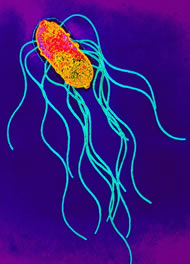
The acute symptoms of Salmonella gastroenteritis include the sudden onset of fever, joint aches, nausea, abdominal cramping, (during peristalsis,) and bloody diarrhea with mucous. The onset of symptoms usually occurs within 6 to 72 hours after the ingestion of the bacteria. The infectious dose is small, probably from 15 to 20 cells but these guys multiply as soon as they get into YOUR GUT.
Doctors tell us there is no real cure for a Salmonella infection (or salmonellosis), except treatment of the symptoms but HOLISTICS have answers. I got Salmonella from undercooked chicken. Got deathly ill, painful cramping, arthritic joints and fever. I asked an expert who said take buffered vitamin c POWDER, healthfood stores have it. Take charcoal capsules (as it is a known holistic remedy for poisons).
As this is a live organism, the usual parasite killer herbs like goldenseal, black walnut, (picked green,) powdered cloves, fresh garlic work well, too. For most strains of Salmonella, the fatality rate is less than one percent so it's not like you're in danger. (You just FEEL like you wish you could die.) You'd have to have a really compromised IMMUNE system to be in danger, but you sure won't feel good. The cramps in lower bowel are intense.
Salmonella infections usually resolve in five
to seven days, and many times require no treatment, unless the patient
becomes severely dehydrated or the infection spreads from the intestines.
Persons with severe diarrhea may require rehydration, often with intravenous
fluids. Treatment with antibiotics is not usually necessary, unless the
infection spreads from the intestines, or otherwise
persists, in which case the infection can be treated with ampicillin, gentamicin,
trimethoprim/sulfamethoxazole, or ciprofloxacin. Some Salmonella bacteria
have become resistant to antibiotics, however, and this has occurred possibly
as a result of the use of antibiotics to promote the
growth of feed animals.
Are there any serious medical problems that can arise from a Salmonella infection?
Typically, nontyphoidal Salmonella produces a self-limiting febrile gastrointestinal illness that is indistinguishable from that caused by other bacterial enteric pathogens. Dehydration is the principal clinical concern. The incubation period between ingestion of Salmonella bacteria and the onset of illness varies from 6 to 72 hours.
Symptoms of Salmonella infection include diarrhea,
abdominal cramps, fever, nausea, and/or vomiting. The diarrhea may be non-bloody,
occur several times per day, and not be very voluminous, although in severe
cases it may be frequent, bloody and/or mucoid,
and of high volume. Fever generally occurs in the 38°C to 39°C
range. Vomiting is less common than diarrhea. Headaches, myalgias (muscle
pain), and arthralgias
(joint pain) are often reported as well. Whereas
the diarrhea typically lasts 24 to 72 hours, patients often report fatigue
and
other nonspecific symptoms lasting 7 days or longer.
I personally had painful cramping for weeks afterwards but only when a bowel movement was coming.
Reiter's Syndrome:
Reiterís syndrome, which includes and is sometimes
referred to as ďreactive arthritis,Ē is an uncommon, but debilitating,
result of a Salmonella infection. I had this. JOINTS immediately became
painful. Swollen up. Reiterís syndrome is a disorder that causes at least
two of three seemingly unrelated symptoms: reactive arthritis, eye
irritation, and urinary tract infection. The
reactive arthritis associated with Reiterís develops when a person eats
food that has been tainted with bacteria. Reactive arthritis is characterized
by the inflammation of one or more joints, following an infection localized
in another portion of the body, commonly the gastrointestinal tract. The
symptoms of Reiterís Syndrome usually occur between
one and three weeks after the infection but I got it the first day out.
It was almost like a food allergy, so quick was it to appear.
The three most common symptoms of Reiterís syndrome are arthritis, eye irritation, and urinary tract symptoms. The arthritis associated with Reiterís syndrome typically affects the knees, (true for me,) ankles, and feet, causing pain and swelling. Wrists, fingers and other joints can be affected, (true in my case, also) though with less frequency. Patients with Reiterís syndrome commonly develop inflammation where the tendon attaches to the bone, a condition called enthesopathy. Some patients with Reiterís syndrome also develop heel spurs, bony growths in the heel that cause chronic or long-lasting foot pain. Arthritis from Reiterís syndrome can also affect the joints of the back and cause spondylitis, inflammation of the vertebrae in the spinal column. The duration of reactive arthritis symptoms can vary greatly. Most of the literature suggests that the majority of patients recover within a year. The condition, can, however, be permanent. One study found nearly 50% of patients with post dysenteric reactive arthritis continued to have symptoms roughly one year after onset.
The involvement of the eye in Reiterís syndrome is most commonly manifested as conjunctivitis, inflammation of the mucous membrane that covers the eyeball, or uveitis, an inflammation of the inner eye. Conjunctivitis and uveitis can cause redness of the eyes, eye pain and irritation, and blurred vision.
The third site for Reiterís syndrome symptoms is the urogenital tract. This includes the prostate, urethra, and penis in men and the fallopian tubes, uterus, and vagina in women. Men may notice an increased need to urinate, a burning sensation when urinating, and a discharge from the penis. Some men also develop prostatitis. Symptoms of prostatitis include fever, chills, increased need to urinate, and a burning sensation when urinating.
DIFFERENT INFORMATION IS HERE: http://home.earthlink.net/~anitaastrologer/salmonella2.htm
http://www.salmonella.org/faq.html